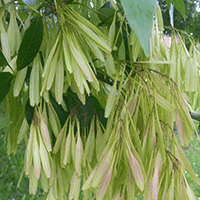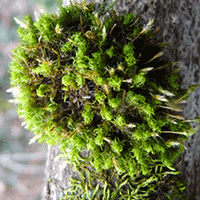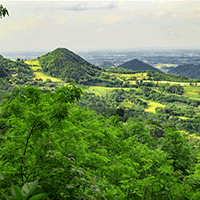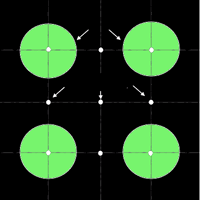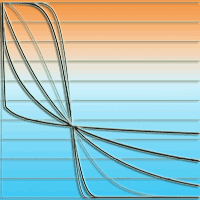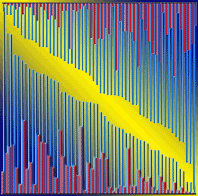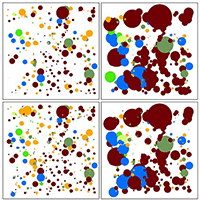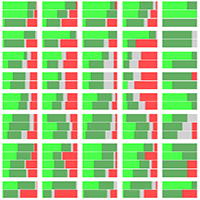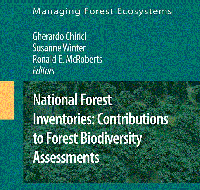With the increased planting of non-native trees within urban environments there is a need for investigating the impacts they may have on the indigenous biodiversity. In this study, we explored the diversity of epiphytic lichens and bryophytes as well as the tree-related microhabitats on planted, non-native green ash Fraxinus pennsylvanica and compared it to that of indigenous Fraxinus excelsior and Quercus robur. We conducted sampling on trees of similar growing conditions and size within two cities of eastern Germany (Dresden and Dessau-Roßlau). In our analysis we did not find any significant differences in epiphyte diversity and abundance. By contrast, microhabitat diversity was significantly higher on F. pennsylvanica than on the indigenous tree species, which we attribute to the pioneer character of F. pennsylvanica with faster ageing. Our results underline a low impact of F. pennsylvanica on epiphytic lichen and bryophyte diversity, while indigenous animals might even benefit from the higher diversity and frequency of microhabitats on trees of this species. Therefore, its use as an ornamental tree should not be generally rejected in urban environments.
Keywords
, , ,
Citation
Dittrich S, Thiem E, Albrecht BM, von Oheimb G (2021). Cryptogamic epiphytes and microhabitat diversity on non-native green ash (Fraxinus pennsylvanica Marsh., Oleaceae) in urban habitats. iForest 14: 393-399. - doi: 10.3832/ifor3739-014
Paper history
Received: Jan 08, 2021
Accepted: Jul 06, 2021
First online: Sep 01, 2021
Publication Date: Oct 31, 2021
Publication Time: 1.90 months
© SISEF - The Italian Society of Silviculture and Forest Ecology 2021
Open Access
This article is distributed under the terms of the Creative Commons Attribution-Non Commercial 4.0 International (https://creativecommons.org/licenses/by-nc/4.0/), which permits unrestricted use, distribution, and reproduction in any medium, provided you give appropriate credit to the original author(s) and the source, provide a link to the Creative Commons license, and indicate if changes were made.

Breakdown by View Type
(Waiting for server response...)
Article Usage
Total Article Views: 32094
(from publication date up to now)
Breakdown by View Type
HTML Page Views: 27285
Abstract Page Views: 2236
PDF Downloads: 2037
Citation/Reference Downloads: 1
XML Downloads: 535
Web Metrics
Days since publication: 1550
Overall contacts: 32094
Avg. contacts per week: 144.94
Article Citations
Article citations are based on data periodically collected from the Clarivate Web of Science web site
(last update: Mar 2025)
Total number of cites (since 2021): 2
Average cites per year: 0.40
Publication Metrics
by Dimensions ©
Articles citing this article
List of the papers citing this article based on CrossRef Cited-by.
(1)
Albrecht BM, von Oheimb G (2018)Erste Ergebnisse zum Einfluss der Rot-Esche auf die Biodiversität an der Elbe [First results on the impact of green ash on the biodiversity at the river Elbe]. Naturschutz im Land Sachsen-Anhalt 55 Sonderheft: 87-91. [in German]
Gscholar
(2)
Bates JW, Brown DH (1981)Epiphyte differentiation between
Quercus petraea and
Fraxinus excelsior trees in a maritime area of South West England. Vegetatio 48: 61-70.
CrossRef |
Gscholar
(3)
Bernhofer C, Matschullat J, Bobeth A (2009)Das Klima in der REGKLAM-Modellregion Dresden [Climate in the REGKLAM model region Dresden]. RHOMBOS-Verlag, Berlin, Germany, pp. 117. [in German]
Gscholar
(4)
Boch S, Müller J, Prati D, Blaser S, Fischer M (2013)Up in the tree - The overlooked richness of bryophytes and lichens in tree crowns. PLoS One 8 (12): e84913.
CrossRef |
Gscholar
(5)
Böll S (2018)Stadtbäume der Zukunft - Wichtige Ergebnisse aus dem Forschungsprojekt “Stadtgrün 2021” [Future urban trees - Important results of the research project “Stadtgrün 2021”]. Veitshöchheimer Berichte 184: 75-85. [in German]
Gscholar
(6)
Bovyn RA, Lordon MC, Grecco AE, Leeper AC, LaMontagne JM (2019)Tree cavity availability in urban cemeteries and city parks. Journal of Urban Ecology 5 (1): 139.
CrossRef |
Gscholar
(7)
Buttler KP, Hand R (2008)Liste der Gefäßpflanzen Deutschlands [List of vascular plants of Germany]. Kochia, Beiheft 1: 1-107. [in German]
Gscholar
(8)
Caspari S, Dürhammer O, Sauer M, Schmidt C (2018)Rote Liste und Gesamtartenliste der Moose (Anthocerotophyta, Marchantiophyta und Bryophyta) Deutschlands [Red list and total species list of german bryophytes]. Naturschutz und Biologische Vielfalt 70 (7): 361-489. [in German]
Gscholar
(9)
Clarke KR (1993)Nonparametric multivariate analyses of changes in community structure. Australian Ecology 18: 117-143.
CrossRef |
Gscholar
(10)
Climate-data.org (2020)Daten und Graphen zum Klima und Wetter für Dessau-Roßlau [Data and graphs on climate and weather for Dessau-Roßlau]. Website. [in German]
Online |
Gscholar
(11)
Danielewicz W, Wiatrowska B (2014)Inwazyjne gatunki drzew i krzewów w lasach Polski [The most invasive tree and shrub species in Polish forests]. Peckiana 9: 59-67. [in Polish]
Gscholar
(12)
DDG (2020)Rekordbäume [Champion-Trees]. Website. [in German]
Online |
Gscholar
(13)
Dickie IA, Bennett BM, Burrows LE, Nuñez MA, Peltzer DA, Porté A, Richardson DM, Rejmánek M, Rundel PW, Van Wilgen BW (2014)Conflicting values: ecosystem services and invasive tree management. Biological Invasions 16: 705-719.
CrossRef |
Gscholar
(14)
Dierßen K (2001)Distribution, ecological amplitude and phytosociological characterization of European bryophytes. Bryophytorum Bibliotheca 56, pp. 289.
Online |
Gscholar
(15)
Dittrich S, Hauck M, Jacob M, Rommerskirchen A, Leuschner C (2013)Response of ground vegetation and epiphyte diversity to natural age dynamics in a Central European mountain spruce forest. Journal of Vegetation Science 24: 675-687.
CrossRef |
Gscholar
(16)
Doroski DA, Ashton MS, Duguid MC (2020)The future urban forest - A survey of tree planting programs in the Northeastern United States. Urban Forestry and Urban Greening 55: 126816.
CrossRef |
Gscholar
(17)
DWD (2020)Niederschlag: vieljährige Mittelwerte 1971-2000 [Precipitation: long-term mean 1971-2000]. Website. [in German]
Online |
Gscholar
(18)
Fojcik B, Stebel A (2001)Struktura ekologiczna i przestrzenna brioflory miasta Katowice [Ecological and spatial structure of bryoflora of Katowice town]. Materialy Opracowania Centrum Dziedzictwa Przyrody Górnego Slaska w Katowicach 5: 1-128. [in Polish]
Gscholar
(19)
Fox J (2017)Using the R Commander: a point-and-click interface for R. Chapman and Hall/CRC Press, Boca Raton, FL, USA, pp. 213.
Gscholar
(20)
Fröhlich A, Ciach M (2020)Dead tree branches in urban forests and private gardens are key habitat components for woodpeckers in a city matrix. Landscape and Urban Planning 202: 103869.
CrossRef |
Gscholar
(21)
Fudali E, Szymanowski M (2019)Epiphytic bryophytes on alien host-tree species in Wroclaw (SW Poland). Cryptogamie Bryologie 40: 117-129.
CrossRef |
Gscholar
(22)
Gallé L (1966)Lichen flora of the forty years old botanical garden in Szeged. Tiscia 2: 41-46.
Online |
Gscholar
(23)
Gallé L (1970)Die Flechtenvegetation und Flechtenzönosen des Arboretums in Szarvas [Lichen vegetation and lichen communities of the Szarvas arboretum]. Acta Biologica Szeged 16: 43-49. [in German]
Gscholar
(24)
Gomolka A (2017)Das Projekt Rekordbäume / Champion-Trees in Deutschland [The project “Record master trees / Champion-Trees in Germany]. DDG-Mitteilungen 102: 261-269.
Online |
Gscholar
(25)
Gossner MM (2016)Introduced tree species in central Europe - Consequences for arthropod communities and species interactions. In: “Introduced Tree Species in European Forests: Opportunities and Challenges” (Krumm F, Vítková L eds). European Forest Institute, Freiburg, Germany, pp. 264-282.
Online |
Gscholar
(26)
Hammer O, Harper DAT, Ryan PD (2001)PAST: Paleontological statistics software package for education and data analysis. Palaeontologia Electronica 4 (1): 9.
Online |
Gscholar
(27)
Hauck M (2005)Epiphytic lichen diversity on dead and dying conifers under different levels of atmospheric pollution. Environmental Pollution 135: 111-119.
CrossRef |
Gscholar
(28)
Hauck M, Otto PI, Dittrich S, Jacob M, Bade C, Dörfler I, Leuschner C (2011)Small increase in substratum pH causes the dieback of one of Europe’s most common lichens,
Lecanora conizaeoides. Annals of Botany 108: 359-366.
CrossRef |
Gscholar
(29)
Hyerczyk RD (2005)The lichen flora of ten Chicago parks, Chicago Park District, Chicago, Illinois. Transactions of the Illinois State Academy of Science 98: 97-122.
Online |
Gscholar
(30)
John V, Stapper NJ (2015)Schwarznuss (
Juglans nigra) in Auwäldern am Rhein als bedeutender Trägerbaum für Flechten und Moose in Rheinland-Pfalz [Black walnut (
Juglans nigra) in riparian forests along the Rhine valley as an important phorophyte for lichens and bryophytes in Rheinland-Pfalz]. Herzogia 28: 405-429. [in German]
CrossRef |
Gscholar
(31)
Kraus D, Bütler R, Krumm F, Lachat T, Larrieu L, Mergner U, Paillet Y, Rydkvist T, Schuck A, Winter S (2016)Katalog der Baummikrohabitate - Referenzliste für Feldaufnahmen [Catalogue of tree microhabitats - Reference fieldlist]. Technical Paper, Integrate+, German Federal Ministry of Food and Agriculture - BMEL, Bonn, Germany, pp. 16. [in German]
Gscholar
(32)
Krause U, Patzak U, Eichhorn A (2008)Nischenstruktur und Vogelbesiedlung von Roteschenbeständen auf feuchten Auenstandorten [Niche structure and bird colonization of green ash stands at moist alluvial sites]. Veröffentlichungen LPR Landschaftsplanung Dr. Reichhoff GmbH 4: 47-53. [in German]
Gscholar
(33)
Larrieu L, Gosselin F, Archaux F, Chevalier R, Corriol G, Dauffy-Richard E, Deconchat M, Gosselin M, Ladet S, Savoie J-M, Tillon L, Bouget C (2018)Cost-efficiency of cross-taxon surrogates in temperate forests. Ecological Indicators 87: 56-65.
CrossRef |
Gscholar
(34)
Liška J, Herben T (2008)Long-term changes of epiphytic lichen species composition over landscape gradients: an 18 year time series. The Lichenologist 40: 437-448.
CrossRef |
Gscholar
(35)
Litt AR, Cord EE, Fulbright TE, Schuster GL (2014)Effects of invasive plants on Arthropods. Conservation Biology 28: 1532-1549.
CrossRef |
Gscholar
(36)
Lüth M (2010)Ökologie und Vergesellschaftung von
Orthotrichum rogeri [Ecology and phytosociology of
Orthotrichum rogeri]. Herzogia 23: 121-149. [in German]
CrossRef |
Gscholar
(37)
Matwiejuk A, Chojnowska P (2016)Lichens of Lomza town (Podlasie, North-Eastern Poland). Steciana 20: 53-62.
CrossRef |
Gscholar
(38)
Mitchell RJ, Broome A, Beaton JK, Bellamy PE, Ellis CJ, Hester AJ, Hodgetts NG, Iason GR, Littlewood NA, Newey S, Pozsgai G, Ramsay S, Riach D, Stockan JA, Taylor AFS, Woodward S (2017)Challenges in assessing the ecological impacts of tree diseases and mitigation measures: the case of
Hymenoscyphus fraxineus and
Fraxinus excelsior. Baltic Forestry 23: 116-140.
Online |
Gscholar
(39)
Mitchell RJ, Hewison RL, Beaton J, Douglass JR (2021)Identifying substitute host tree species for epiphytes: the relative importance of tree size and species, bark and site characteristics. Applied Vegetation Science 24: e12569.
CrossRef |
Gscholar
(40)
Nehring S, Kowarik I, Rabitsch Essl W (2013)Naturschutzfachliche Invasivitätsbewertungen für in Deutschland wild lebende gebietsfremde Gefäßpflanzen [Classification of the invasiveness of wild, non-native, vascular plants in Germany with regard to nature conservation]. BfN-Skripten 352, pp. 202. [in German]
Online |
Gscholar
(41)
Paillet Y, Archaux F, Puy S, Bouget C, Boulanger V, Debaive N, Gilg O, Gosselin F, Guilbert E (2018)The indicator side of tree microhabitats: a multi- taxon approach based on bats, birds and saproxylic beetles. Journal of Applied Ecology 55: 2147-2159.
CrossRef |
Gscholar
(42)
Paillet Y, Debaive N, Archaux F, Cateau F, Gilg O, Guilbert E (2019)Nothing else matters? Tree diameter and living status have more effects than biogeoclimatic context on microhabitat number and occurrence: an analysis in French forest reserves. PLoS One 14 (5): e0216500.
CrossRef |
Gscholar
(43)
Prather HM, Eppley SM, Rosenstiel TN (2018)Urban forested parks and tall tree canopies contribute to macrolichen epiphyte biodiversity in urban landscapes. Urban Forestry and Urban Greening 32: 133-142.
CrossRef |
Gscholar
(44)
Prots B, Drescher A, Vykhor B (2011)Invasion ecology of Green Ash
Fraxinus pennsylvanica Marsh. in the Transcarpathia (Ukraine). Journal of Biological Systems 3: 269-276.
Gscholar
(45)
R Core Team (2020)R: a language and environment for statistical computing. R Foundation for Statistical Computing, Vienna, Austria.
Online |
Gscholar
(46)
Richter S, Schütze P, Bruelheide H (2009)Untersuchungen zu Flora und Vegetation der epiphytischen Moose in Halle/Saale (Sachsen-Anhalt) [Study of the flora and vegetation of epiphytic bryophytes in Halle/Saale (Saxony-Anhalt)]. Hercynia NF 42: 177-195. [in German]
Online |
Gscholar
(47)
Roloff A, Gillner S, Kniesel R, Zhang D (2018)Interesting and new street tree species for European cities. Journal of Forest and Landscape Research 1: 1-7.
CrossRef |
Gscholar
(48)
Schlaepfer MA, Sax DF, Olden J (2011)The potential conservation value of non-native species. Conservation Biology 25: 428-437.
CrossRef |
Gscholar
(49)
Schmiedel D (2011)Fraxinus pennsylvanica Marschall, 1785. In: “Enzyklopädie der Holzgewächse: Handbuch und Atlas der Dendrologie” (Schütt P, Schuck HJ, Aas G, Lang U eds). Wiley, Suppl. 57 (3/2011), pp. 1-12. [in German]
Online |
Gscholar
(50)
Schmiedel D, Huth F, Wagner S (2013)Using data from seed-dispersal modelling to manage invasive tree species: the example of
Fraxinus pennsylvanica Marshall in Europe. Environmental Management 52: 851-860.
CrossRef |
Gscholar
(51)
Sladonja B, Sušek M, Guillermic J (2015)Review on invasive Tree of Heaven (
Ailanthus altissima (Mill.) Swingle). Conflicting values: assessment of its ecosystem services and potential biological threat. Environmental Management 56: 1009-1034.
CrossRef |
Gscholar
(52)
Smith DM, Finch DM (2014)Use of native and nonnative nest plants by riparian-nesting birds along two streams in New Mexico. River Research and Applications 30: 1134-1145.
CrossRef |
Gscholar
(53)
Stapper NJ, John V (2015)Monitoring climate change with lichens as bioindicators. Pollution Atmosphérique 226: 1-12.
Online |
Gscholar
(54)
VDI (2017)VDI standard 3957 Part 20: biological measuring techniques for the determination and evaluation of effects of air pollutants (biomonitoring). Mapping of lichens to indicate local climate change. Verein Deutscher Ingenieure - VDI, Berlin, Germany, pp. 35.
Gscholar
(55)
Wirth V, Hauck M, De Bruyn U, Schiefelbein U, John V, Otte V (2009)Flechten aus Deutschland mit Verbreitungsschwerpunkt im Wald [Lichens typically occurring in forests of Germany]. Herzogia 22: 79-107. [in German]
Online |
Gscholar
(56)
Wirth V, Hauck M, Schultz M (2013)Die Flechten Deutschlands [Lichens of Germany]. Ulmer Verlag, Stuttgart, Germany, vol. 1+2, pp. 1244.
Gscholar
(57)
Zapponi L, Minari E, Longo L, Toni I, Mason F, Campanaro A (2014)The Habitat-Trees experiment: using exotic tree species as new microhabitats for the native fauna. iForest 8: 464-470.
CrossRef |
Gscholar
